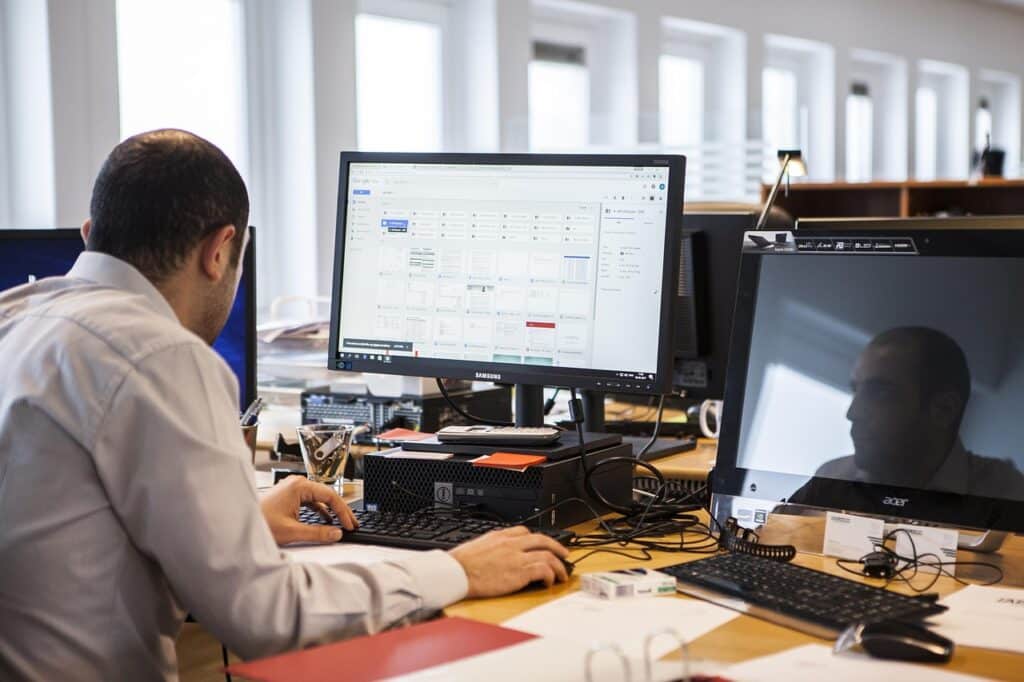Good project management with fixed-price time tracking relies on rigorous planning and efficient resource management. The use of CRA (time and resource tracking) software ensures accurate tracking of time and planning, offering the flexibility needed to adapt to unforeseen circumstances, improve invoicing and meet deadlines. Optimized planning is essential in the IT and software development sectors. It helps to improve productivity, ensure job success and guarantee customer satisfaction.
Optimize time tracking for efficient project management
Whether you’re an IT services company, an ESN, an agency communications agency or even a freelance consultant in the field of software software and development, keeping track of the time spent on your assignments is essential. This step is even more important when you’re committing to a fixed-price you commit to a fixed-price contract in order to meet specifications.
The fixed-price project management is of vital importance, not only for monitoring profitability, but also for maintaining a healthy, transparent relationship with your customers.
Having a clear and precise idea of the scope of the work carried out in relation to what was initially agreed in the specifications enables you to highlight the “work still to be done” and avoid any surprises or misunderstandings with the client. This is all the more crucial in the IT sector, where projects can rapidly evolve and become complex, requiring technical assistance and rigorous follow-up.

Of course, the success of this approach depends closely your ability to integrate these monitoring practices into your company’s day-to-day operations. It is also important to strengthen the skills of your teams, so that they can evolve in line with these new working methods.
You probably have many questions: How to optimize intervention time tracking without disrupting operations and the established order? How to provide my clients with an exhaustive and flawless view of project progress ? How to ensure the implementation of a solution that will meet the specific needs of each mission, while respecting established deadlines and budget?
By taking these different elements into account, and by implementing the necessary means, you will be in a position to win the challenges linked to time tracking in a fixed-price or time-and-material while minimizing the risk of penalties. Maximize your chances of success with CRA software.
The importance of CRA software
To facilitate tracking time spent on a fixed-price project, it is essential to adopt corporate time management tools , such as CRA software . This type of solution not only allows for precise tracking of hours worked but also automates activity management and invoicing.
By offering a clear and detailed view of tasks performed, CRA software (activity report) optimizes the management of your missions and improves the profitability of your projects. It thus becomes an indispensable asset for ensuring transparency and client satisfaction.
What are the obstacles to tracking time spent?
In fact, although this is central to the smooth running of the business, there are often several problems that arise:
- It’s a pain! Let’s be honest, logging daily time is often perceived by teams as a tedious and unrewarding task. This is understandable given that profitability concerns are often far removed from those who have to log their time every day…
- Self-reporting is often judge and jury. The one doing the work is also the one reporting it, so if they report inaccurately, it creates issues. Or how to charge the client for more coffee breaks than the actual progress of their project…
- Difficulty controlling. Indeed, this kind of declarative system requires someone to check regularly (ideally every week) that what is entered has actually been done.
Why is time recording often perceived as a chore by teams?
Logging time spent on projects can quickly become a source of frustration for teams. Here are some reasons why this task is often perceived as a chore:
- Lack of understanding: team members don’t always clearly see how logging their actual time benefits the project or the company. They may feel that this management method increases workload and serves only for monitoring rather than process improvement.
- Repetitive and tedious task: Entering your time every day or every week can seem repetitive and tedious, especially if the system used is not user-friendly.
- Lack of time: paradoxically, team members may feel too busy with their daily tasks to take the time to properly capture their time.
- Negative perception : there may be a fear that the information captured will be used against them by project managersespecially if the project is behind schedule or over budget.

How can we overcome the problem of declarative time tracking?
Self-reporting, though essential, presents its share of challenges in time tracking and IT project management. Here are some strategies to overcome these issues:
- Training and awareness: Make sure your teams understand the importance of capturing their time and how this can benefit everyone, improving transparency and enabling better project management.
- Use user-friendly management tools: invest in time tracking systems that are easy to use and implement. Updates should be quick and effortless.
- Encourage regularity: Encourage your teams to enter their time on a regular basis, for example at the end of each day or task, so that it becomes a habit.
- Involve your teams in the process: give your teams the opportunity to participate in time tracking tools and methods, so that they feel more involved and responsible.
- Leading by example: Leaders and managers need to set an example by capturing their own time rigorously and transparently.
- Positive feedback: Stress the importance of time tracking and congratulate team members who do it correctly and regularly.
By addressing these aspects, you’ll help create a positive culture around time capture, transforming a task perceived as a chore into a key element for project success. This makes it possible to implement an agile method aimed at improving risk management.
How do you make the most of your time on a fixed-price project?
At Furious, we’ve come up with a whole host of possible scenarios, so that everyone can get involved in the fun!
Track your time and optimize your productivity :
- From your Outlook or Gmail calendar with automatic synchronization.
- With a great widget where you can enter everything you’ve done in the past week (see screenshot).
- With a time tracker of death: play / pause / play / pause… “on the phone with a customer” etc…
- Directly from the schedule with intelligent production vs. project management notifications
- With time entry directly at ticket close.
How to use your calendar and synchronization tools to keep track of time?
Using your diary can be an effective and intuitive way of keeping track of the time spent on your projects. Here’s how to get the most out of it:
- Automatic synchronization: ensure your calendar is synchronized with your time tracking tools. Whether you use Outlook, Gmail, or any other calendar, automatic synchronization allows you to log your time as you go, without extra effort.
- Creation of dedicated events: create specific events for each task or project. Make sure to name them clearly and include all necessary details.
- Use of categories and colors: use categories and colors to differentiate between task and project types. This will make your tracking visually intuitive and easy to analyze.
- Retrospection Take the time at the end of each week to look back at your diary to make sure everything’s been recorded, and adjust it if necessary.
The use of widgets and time trackers for optimized time recording
Widgets and time trackers are invaluable tools for optimized time recording. Here’s how to make the most of them:
- Widgets on desktop or mobile Use widgets accessible directly from your desktop or cell phone to capture your time quickly and without interrupting your workflow.
- Play/pause function: choose a time tracker that offers a play/pause feature. This allows you to start and stop the timer with one click, which is ideal for tasks requiring high precision in time tracking.
- Categorization: ensure your widget or time tracker allows you to categorize your tasks. This will facilitate time analysis and help you identify areas where you can gain efficiency.
- Reports and analytics: choose a tool that offers reporting and analytics features. This will allow you to visualize your time data in a comprehensible and actionable way to better meet project objectives.
How can I integrate time recording into the ticket closing workflow?
Integrating time recording directly into the ticket closing workflow can greatly optimize your process. Here’s how it works:
- Automation : set up an automation that reminds the user to enter his time when closing the ticket.
- Mandatory fields: make time entry mandatory to close a ticket. This ensures that time is accounted for every completed task.
- Guides and tooltips Provide guides and tooltips in the time entry field to help users understand how and why to enter their time.
- Feedback and continuous improvement Collect user feedback and continually improve the process to make it as smooth and intuitive as possible.
By following these tips, you’ll optimize time recording within your team, contributing to better project management and increased productivity.
And from an HR point of view?
Internally, we can’t advise you enough to orchestrate the entire process and take all components into account. To find out, ask yourself these questions:
- Do you reward those who enter their time? For example, priority access to the production schedule, etc.
- Do you systematically check that timesheets are complete?
- What do you do if it isn’t done? In a large consulting firm that we won’t name, if the charges aren’t done on Friday evening, it’s up to the manager to do them for the employee on the following Monday… In general, this doesn’t happen twice!
- Have you gamified the process to make it fun?
- Have you given “project” meaning to the action of imputing? For example, premium on project profitability, etc.
How can you motivate your teams to make the most of their time?
Valuing and motivating your teams to accurately log their time is crucial for the success and precision of your project management . Here’s how to achieve it:
- Recognition: implement a recognition system for team members who accurately and regularly log their time. This can take the form of public praise, rewards, or priority access to certain benefits.
- Training and support: ensure that each team member knows how and why it’s important to log their time. Organize training sessions and provide the necessary resources to guide them.
- Process simplification: make the time entry process as simple and quick as possible. The easier it is, the more inclined your teams will be to do it.
- Positive feedback Show your teams how correct time recording contributes to the success of projects and the company’s financial health.
What measures can be taken to ensure the completeness and accuracy of timesheets?
Ensuring the completeness and accuracy of timesheets is essential for efficient time and resource management. Here are the steps to take:
- Regular checks: implement regular checks of timesheets to ensure they are complete and accurate. This can be done by managers or a dedicated team.
- Automatic reminders Use automatic reminders to encourage regular time recording.
- Transparency and communication Be transparent about the importance of timesheet completeness and accuracy, and communicate regularly on the subject.
- Ongoing training : offer ongoing training to remind you of best practices and common mistakes to avoid.
Gamifying time tracking: an effective strategy?
Ensuring the completeness and accuracy of timesheets is essential for efficient time and resource management. Here are the steps to take:
- Regular checks: implement regular checks of timesheets to ensure they are complete and accurate. This can be done by managers or a dedicated team.
- Automatic reminders Use automatic reminders to encourage regular time recording.
- Transparency and communication Be transparent about the importance of timesheet completeness and accuracy, and communicate regularly on the subject.
- Ongoing training: offer ongoing training to remind you of best practices and common mistakes to avoid.
Strategies and tools for effective time management
Effective time tracking is essential to ensure the profitability and success of your projects. To achieve this, the application of good time management techniques helps to optimize work organization and improve visibility on the progress of assignments.
- Use time tracking tools: adopt specialized tools that enable your teams to track their working time accurately and in real time.
- Integration with other tools: make sure your time tracking tool can be integrated with other tools you use, such as project management systems and invoicing software.
- Training and awareness: train your teams in the correct use of the tools and make them aware of the importance of accurate time tracking.
- Data analysis: use the data collected by your time tracking tool to analyze trends, identify areas for improvement and optimize your processes.
Time tracking and project templates
Effective time tracking is essential for profitability. Use real-time tracking tools that can be integrated with your time management and invoicing software. Train your teams and analyze data to optimize your processes.
- Tracking tools Adopt specialized tools for accurate, real-time tracking of working hours.
- Integration Integration: Ensure integration with your project management and billing tools.
- Training Training: Training in correct use and raising awareness of the importance of accurate monitoring.
- Analysis Use data to analyze trends and optimize processes.
The choice between a fixed-price project and other models depends on the nature of the project, the customer’s needs and your capabilities.
Comparing and choosing between fixed-price projects and other models
The choice between a fixed-price project and other contractual models depends on many factors, including the nature of the project, the customer’s needs and your in-house capabilities.
Fixed-price project or project management: how to make the right choice?
- Evaluate the project scope: a fixed-price project is often more suitable when the scope and deliverables are clearly defined. Under a time and materials contract, the client pays for the time spent, which can be more flexible if needs evolve.
- Consider the risks: the fixed-price model implies that you assume more risks, as you commit to a fixed price. Under a time and materials contract, risks are more shared with the client.
- Weigh up the financial advantages The financial benefits: a fixed price can offer a better margin if you manage the project well, but it can also lead to losses if the estimate is wrong.
What are the specific advantages of fixed-price projects?
- Financial predictability Financial predictability: both customer and supplier know in advance how much the project will cost.
- Administrative simplicity Once the price has been set, financial management of the project is simplified.
- Efficiency incentive The service provider is encouraged to work efficiently in order to maximize margin.
What are the major differences between fixed-price and time-and-material contracts?
- Billing model In a fixed-price contract, the price is fixed in advance, whereas in a time and materials contract, the customer pays according to the time spent.
- Risk sharing Risks are more on the provider’s side in a fixed-price contract, and more shared in a time and materials contract.
- Flexibility Flexibility: the Time & Material contract offers greater flexibility to adjust scope and resources during the course of the project.
By taking these factors into account, you’ll be better equipped to choose the contractual model best suited to your project and your needs.
In short, as time tracking is an essential prerequisite for the profitable management of your projects, it’s essential to equip your teams with tools that enable them to track their time simply and efficiently, and also to think in terms of internal communications that are both rewarding and motivating!

